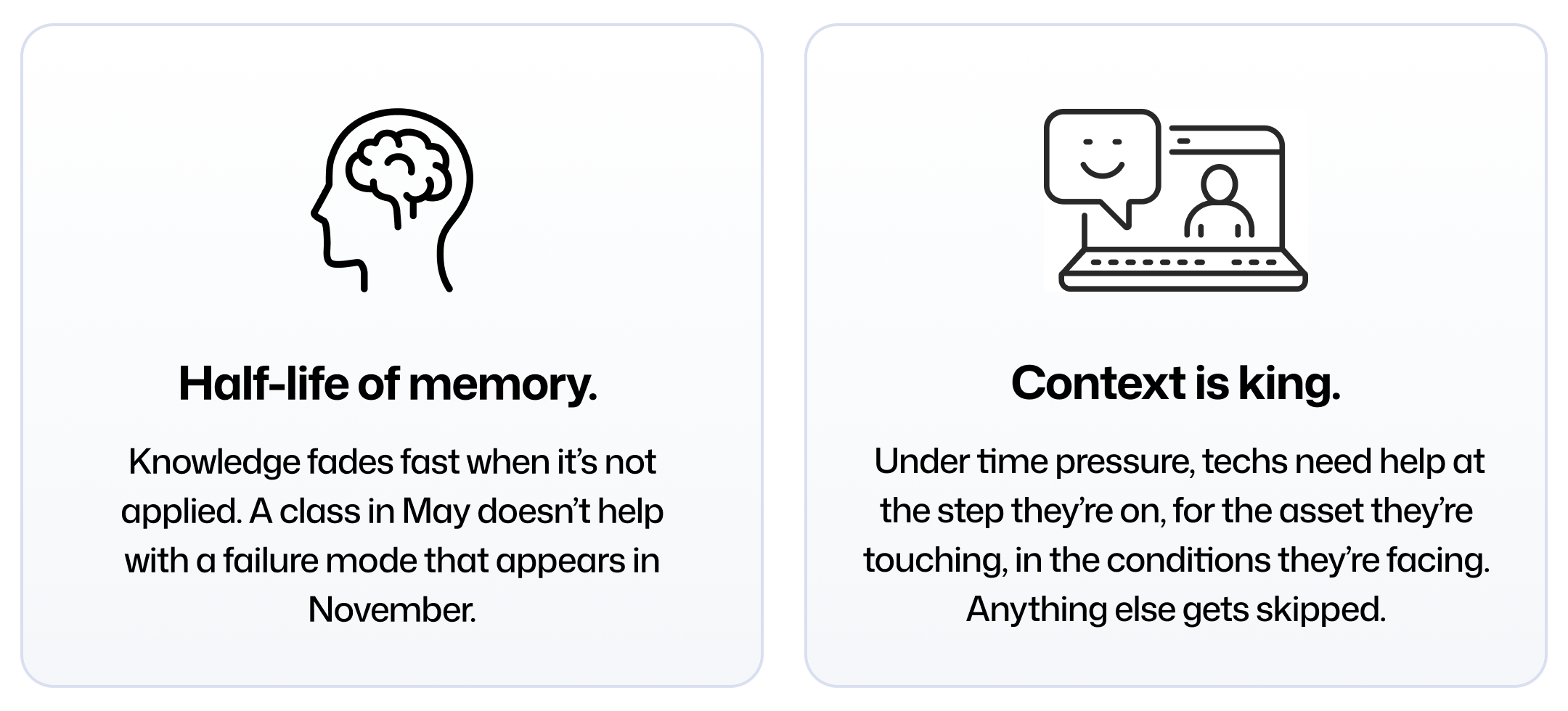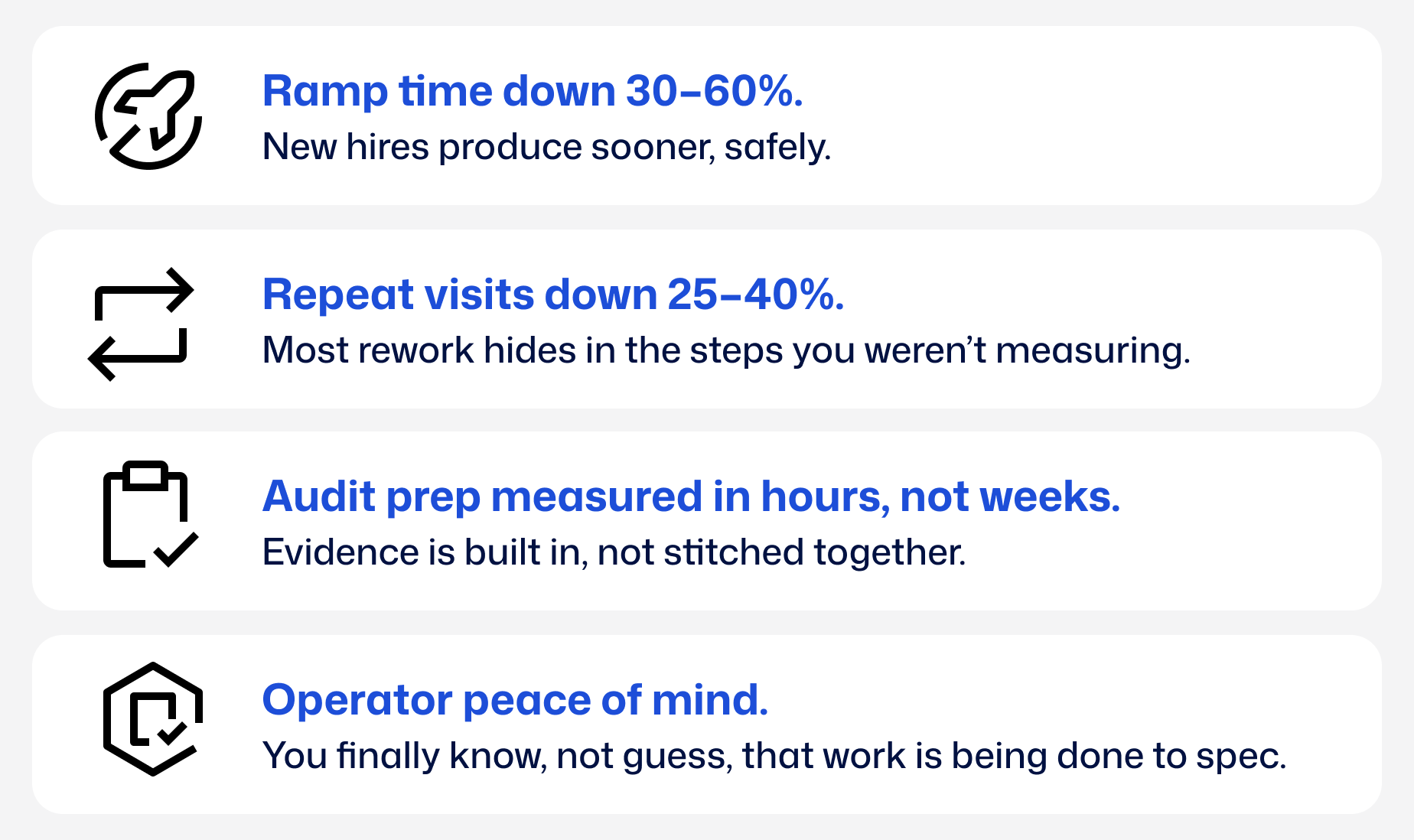
.svg)
It starts with a shift change on a Thursday.
A compressor is due for a seal replacement. The veteran who’s done it a hundred times retired last quarter. The new tech has the PDF. The steps look right. The torque pattern seems fine.
Two days later, vibration spikes. A misalignment … subtle, but expensive … takes the unit offline. No one did anything “wrong.”
They followed the document.
The nuance — the fingertip feel, the one-liner the old hand always muttered — never made it into the SOP.
Multiply that story by every site, every crew, every handover.
That’s the quiet crisis in Oil & Gas.
Your most reliable variable, experience, is aging out faster than your systems can capture it.
And the numbers have caught up.
In early 2025, those over 60 already made up 18% of the Oil & Gas workforce, up sharply from 2021. An unmistakable sign of an accelerating exit wave. At the same time, surveys show a large share of remaining workers actively eyeing other sectors. The “skills cliff” isn’t theoretical anymore; it’s here. Energy Voice+1
You’ve heard the warnings for years. What’s different now isn’t just age.
It’s optionality.
Energy talent has more places to go, and more reasons to go there. That means traditional fixes (mentoring, classroom refreshers, thicker SOP binders) can’t keep pace with the churn. Meanwhile, the operational bar keeps rising: tighter uptime targets, stricter audit demands, thinner margins.
Add it up and you get a new reality: experience alone won’t scale.
Paperwork won’t save you. You need a way to capture, codify, and coach expertise into frontline work, at the speed people are leaving and the speed new people must perform.
Most organizations can show perfect plan data: work orders, parts lists, scheduled windows, and beautiful result data … like closed tickets, financials, KPIs.
What’s missing is the evidence of how work was actually executed in between. That’s exactly where expert judgment used to live.
Without that execution layer, leaders are left with symptoms, not causes:

The result: inconsistent outcomes, longer ramp times, and a creeping loss of confidence — from regulators, partners, and your own teams.
The fix is not a new training portal or a longer procedure.
It’s making expertise a first-class part of the work itself. Captured once, delivered in-flow, and proven with digital evidence. That’s the shift Atheer enables.
Here’s how to make knowledge transfer real (and fast):
Don’t start with a blank SOP.
Start with the person who’s done the job 200 times. Record the execution in context: short clips, annotated photos, voice notes, torque patterns, “if-this-then-that” branches. You’re preserving judgment, not just steps.
Turn raw know-how into interactive SOPs that adapt: different variants for model, environment, or condition. Replace “see manual page 47” with the exact visual on the exact step, automatically version-controlled so older instructions never leak back into the field.
Deliver guidance on the device techs already carry.
Mobile-first, offline-capable.
So they can complete tasks with media prompts, tool check reminders, and torque tables at the precise moment they need them. If something’s unclear, escalate to a remote expert without leaving the job.
Require photo/video validation on critical steps, with timestamps, user IDs, and geolocation where appropriate. Now “done” means “provable,” which shortens audits, ends back-and-forth on warranty, and gives supervisors a real basis for coaching.
Every executed step becomes structured data. See which instructions cause slowdowns, where errors cluster, and which teams outperform on the same job. Feed those insights back to engineering, training, and quality; closing the loop that static SOPs never will.
Traditional training is necessary — but it’s not sufficient. Two realities undermine stand-alone programs:

That’s why the most effective organizations treat training and execution as one continuous system: teach by doing, proof as you go, learn from the data.
Energy markets are unforgiving.
Volatility in prices, regulation, and supply chains is now the baseline. The workforce picture isn’t improving either. Public data sets and industry analyses point to a shrinking pool of experienced hands and a stubborn perception gap with younger talent.
If the only thing standing between your uptime and an avoidable failure is the memory of someone who’s considering retirement — or a role in a different sector — that’s operational fragility, not strategy. Bureau of Labor Statistics.
Three myths keep companies stuck:
Atheer was built for frontline execution in complex, regulated environments.
Under the hood, it’s built like a fortress, with SOC 2 Type II and TISAX AL2 compliance, SSO, and region-appropriate data residency on AWS, so you can scale the solution without adding risk. (Third-party pen-test reports available on request.)
Your teams get the guidance and proof they need; your leadership gets the visibility and assurance auditors demand.
Week 1–2: Find the failure magnets. Pick 3–5 jobs where rework, warranty friction, or safety near-misses cluster. Prioritize by business impact.
Week 3–4: Capture the expert run. Film, annotate, and instrument the “golden path” for each job. Extract the forks: what changes in winter, offshore, or after a certain run-time?
Week 5–6: Ship guided workflows. Convert into interactive SOPs with mandatory validations on critical steps. Pilot with two crews across two sites.
Week 7–8: Measure and harden. Track time-to-complete, error rates, and escalations. Fix what drags. Make the new standard official — and visible.
Quarter 2: Scale. Roll out to adjacent jobs and sites. Move from reaction to prevention with data-driven updates.

“Operator cuts downtime and audit exposure despite wave of retirements.”
That’s not a miracle. It’s what happens when expertise stops living in heads and starts living in the work.
Don’t let the next decade of know-how retire on your watch. Make expertise executable.